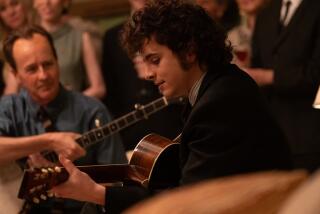Dylan in Transition
- Share via
When Bob Dylan abdicated his folk-music throne in the mid-’60s and embraced rock ‘n’ roll, he changed pop music forever. But many of his fans were vociferously opposed to the transformation.
A new double-CD from Columbia/Legacy Records and a revived film being shown at the Museum of Television & Radio offer a fascinating snapshot of the discord between the artist and his followers during his 1966 European tour, as Dylan waged his singular war against everyone’s expectations.
Having ignored the boos from incensed purists when he plugged in for the first time at the 1965 Newport Folk Festival, Dylan, then 24, went on to tune out and turn off audiences overseas.
The resentment of bewildered British fans during a performance at Manchester’s Free Trade Hall ricochets through the new “Live 1966: The ‘Royal Albert Hall’ Concert--The Bootleg Series Vol. 4,” the long-awaited, pristine-sounding official release of a famous bootleg (on which the concert’s location was misidentified), newly mixed and mastered from the label’s original source tapes.
Disc 1 of the album--which will be released Tuesday--presents the rarely heard solo acoustic portion of the set, with the audience cheering Dylan’s epic guitar-and-harmonica renditions of “Desolation Row” and “Mr. Tambourine Man.” Bliss turns to dismay in the second half, however, when he brings out the amplifiers and his backing group, the Hawks (soon to become the Band): guitarist Robbie Robertson, bassist Rick Danko, organist Garth Hudson, pianist Richard Manuel and drummer Mickey Jones (sitting in for Levon Helm).
In the pauses between riveting versions of “Just Like Tom Thumb’s Blues,” “Ballad of a Thin Man” and the unreleased “Tell Me, Momma,” Dylan meets the crowd’s cries of “Traitor!” with typical We see a lot of intimate glimpses of Dylan brooding, smoking, sparring with reporters, clowning around and playing tourist in odd encounters with the natives. He remains largely inscrutable behind his dark glasses, but a portrait of the artist begins to emerge through the cracks.
caustic wit. But a final accusation of “Judas!” elicits his full venom: “I don’t believe you. You’re a liar.” He exhorts the musicians to play loud for the show-closing “Like a Rolling Stone,” and their thunderous blues-rock juggernaut plows a path to immortality.
If “Live 1966” captures all the glory of Dylan’s risk-taking, paradigm-shifting act, the Museum of Television & Radio’s hourlong presentation of “Eat the Document” preserves the less transcendent aspects of that European tour.
Shot by filmmaker D.A. Pennebaker, who directed the 1965 Dylan documentary “Don’t Look Back,” the production was originally made for television’s “ABC Stage 67.” But it never aired because the decidedly nonlinear documentary (co-edited by Dylan) was deemed too experimental. (The museum is featuring the program in its original form, including vintage commercials. It runs today through Nov. 13.)
The fragmented narrative isn’t likely to befuddle the MTV-trained modern eye, but even now the film proves to be a disorienting, tumultuous array of images. Repetitive visual motifs--train rides, press conferences, hotel rooms--effectively reproduce the monotony of being on the road, as locations and journeys blur together. Eventually, even the hostile fans become one anonymous, whining mass.
We see a lot of intimate glimpses of Dylan brooding, smoking, sparring with reporters, clowning around and playing tourist in odd encounters with the natives. He remains largely inscrutable behind his dark glasses, but a portrait of the artist begins to emerge through the cracks. His changing self-image is revealed in the cuffs of an extravagant, harlequin-patterned shirt beneath his jacket as much as by his slack expression while working through ‘Mr. Tambourine Man” alone on stage.
He looks much more engaged when collaborating with other musicians, whether it’s an impromptu duet with Johnny Cash, hotel-room acoustic noodling with Robertson, or full-on electric splendor with the Hawks during a variety of concert moments. Watching him 32 years later, it’s hard to imagine that so many fans were able to resist. But their lack of appreciation ultimately adds to the drama.
BE THERE
“Eat the Document” screens today at 6 p.m. and Friday through Sunday at 1 p.m. at the Museum of Television & Radio, 465 N. Beverly Drive, Beverly Hills. Suggested donation for museum admission, $6. (310) 786-1000. Through Nov. 13.
More to Read
The biggest entertainment stories
Get our big stories about Hollywood, film, television, music, arts, culture and more right in your inbox as soon as they publish.
You may occasionally receive promotional content from the Los Angeles Times.










